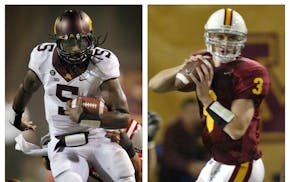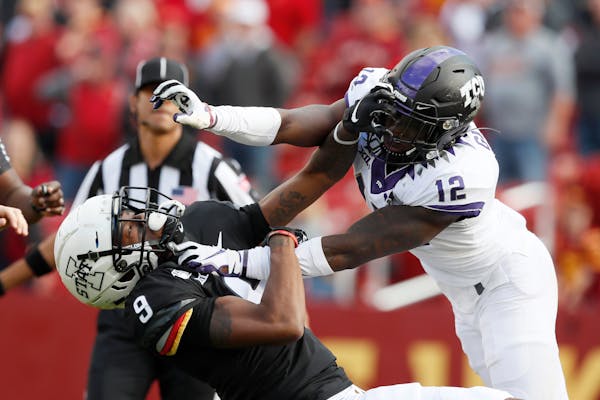With the first of their two first-round selections in the NFL draft on Thursday night, the Vikings used the biggest prize they acquired in the Stefon Diggs trade to select his replacement.
After trading back six spots, they found a first-round cornerback to replace the ones they'd let leave this spring.
They selected LSU's Justin Jefferson with the 22nd overall pick, adding a receiver many expected to be gone by the time the Vikings were on the clock.
Then, with a number of options still available to them at No. 25 overall, they acquired the 117th and 176th overall picks from the 49ers to move back to No. 31, where they took TCU cornerback Jeff Gladney.
"We got a receiver who's going to come in and be an immediate impact player for us," General Manager Rick Spielman said. "As we got to 25, we still had enough names on the board for us to move down to 31 and still get our player. That also gives us enough ammunition for [Friday]; there's a lot of depth through this second and third round, and [we'll] hopefully look forward to manipulating the board to go get some more significant players."
The 6-foot-1 Jefferson frequently lined up in the slot in college, but the Vikings could look to move him and Adam Thielen around to a number of spots as they recreate their passing game with Diggs in Buffalo.
Jefferson caught 111 passes and posted 1,540 yards for the national champions, while playing with Heisman Trophy winner (and No. 1 overall pick) Joe Burrow. He flashed a 37 ½-inch vertical jump and a 4.43-second 40-yard dash at the NFL combine, putting himself in position to go in the first round of a draft thought to be one of the deepest in NFL history at wide receiver.
He figures to add a dynamic element to a receiving group that lost its most productive wideout from a year ago, after the Vikings dealt Diggs and a seventh-rounder to Buffalo for four picks on March 16. The team had signed former Titans receiver Tajae Sharpe in free agency, but needed another option who could take attention away from Thielen and replace some of Diggs' big-play ability on downfield throws.
"He's a guy that we really, really liked," coach Mike Zimmer said. "I know the offensive staff really liked him. Tough, competitive guy — goes up and gets the football. Really good player, good kid, and he played in a very similar offense in college, so I think he'll fit in well."
Gladney stands just 5-foot-10, but rated as one of the best cover corners in the draft thanks to his tenacious style of play at TCU. He could be asked to contribute early in a revamped secondary, as either a nickel cornerback or an outside corner who's unafraid to press bigger receivers.
"Gladney reminded me of a lot of guys who have played similarly for me in the past," Zimmer said. "Very good acceleration, tough, competitive kid, wants to challenge receivers, good in and out of the breaks, long arms. I know he's a shorter guy, but I think he makes up for it with his toughness and his length."
Gladney had surgery in March to trim the meniscus in one of his knees after playing all of the 2019 season and working out at the NFL combine with the injury, but said Thursday night he should be good to go after recovering from the operation.
He suspected the Vikings might take him in the first round; when they called him after trading down, he told them, "I've been waiting on you guys to call," according to Zimmer.
"I had talked to them a few times through this draft process," Gladney said. "I was thinking either [No.] 22 or 25, and then I got a little nervous when they traded back. But I never lost faith in them, though, I still thought they were going to draft me, and they did."
The draft — conducted with team executives in their own homes across the country and Commissioner Roger Goodell announcing picks from his basement in New York — went without a trade in the first 12 picks, before the Buccaneers moved up one spot to No. 13 overall and selected Tristan Wirfs. The Iowa product became the fourth tackle selected in the first 13 picks, with the Vikings nine picks away from potentially selecting a lineman at No. 22 overall. USC's Austin Jackson was the fifth lineman taken by the Dolphins at No. 18.
The second 10 picks of the draft also saw a run on receivers, as Alabama's Henry Ruggs III and Jerry Jeudy went before Oklahoma's CeeDee Lamb. And after the Jaguars took Florida cornerback C.J. Henderson ninth overall, the Falcons selected Clemson cornerback A.J. Terrell 16th overall, taking another player off the board that might have been a fit in Minnesota had he lasted until the 22nd overall pick.
According to an NFL source, the team had talked with the Raiders about moving up from No. 22 to the 19th pick, but Las Vegas was asking for the Vikings' second-rounder (No. 58 overall) to complete the deal. Instead, the Vikings chose the road they've taken more frequently during Rick Spielman's tenure as general manager, moving back in exchange for more options on the third day of the draft.

Twins find fuel in back-to-back homers, defeat Blue Jays

Players to watch in Minnesota's girls flag football state tournament

Twins lose Matthews to injury; Woods Richardson likely to join rotation

Former Gophers football standouts embrace being basketball dads


